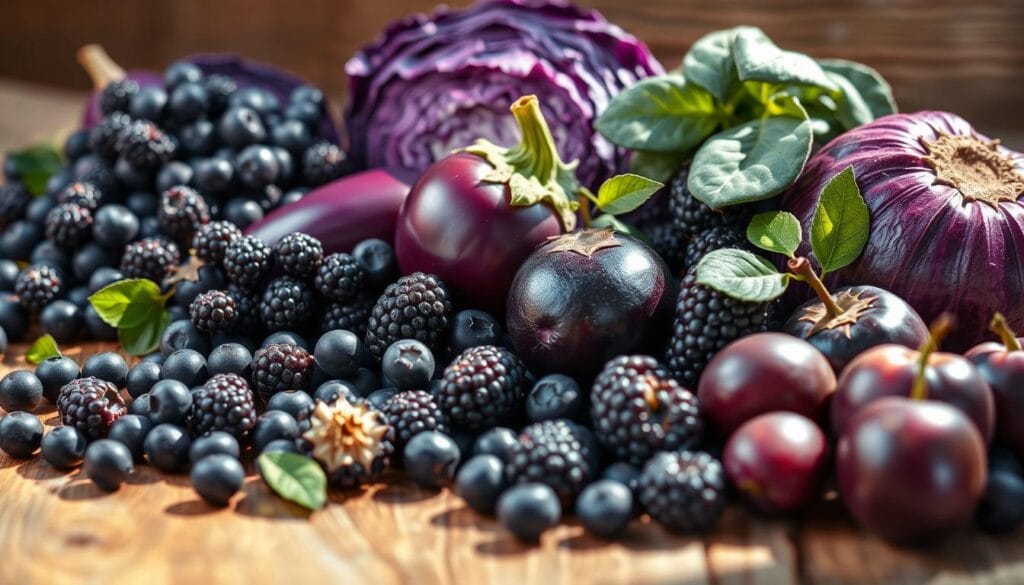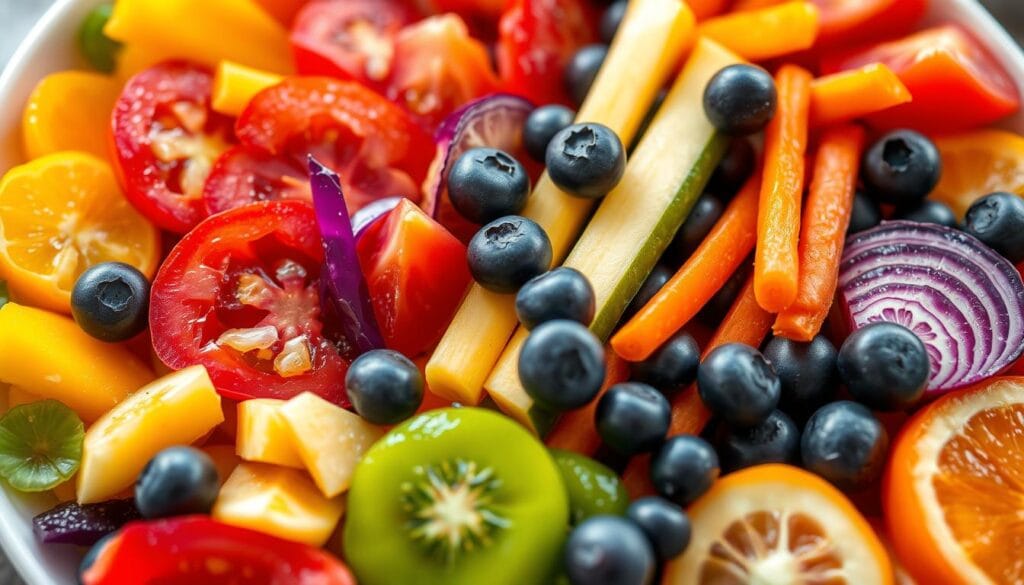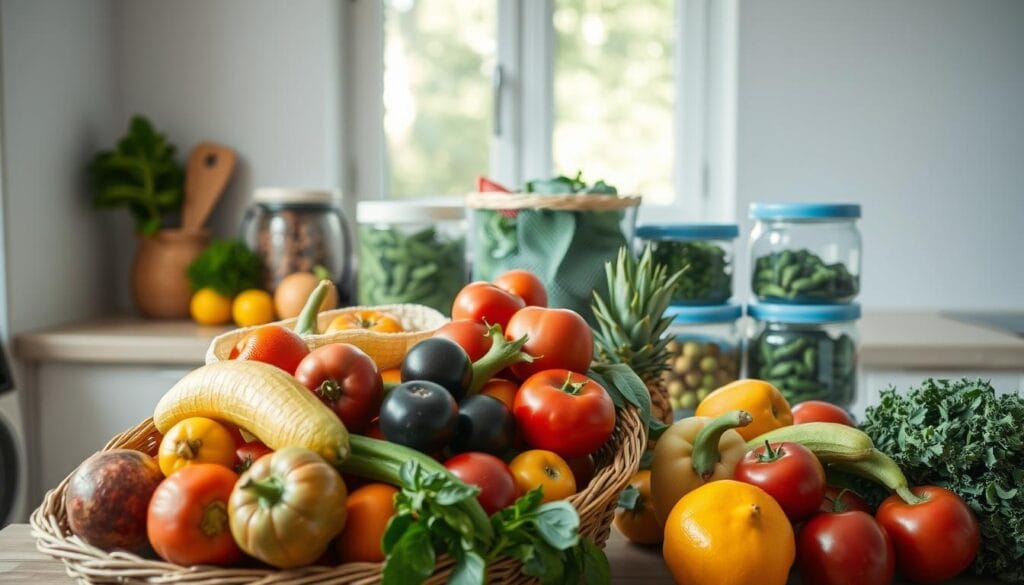Rainbow Plate of Fruit and Vegetables: 7 Best Combos for Health
Table of Contents
Ever looked at your plate and felt something was off? Your body wants more than just plain meals. The key to feeling great is to make a Rainbow Plate of Fruit and Vegetables.
Think about making every meal a colorful feast. It’s not just about looks; it’s about getting the nutrients your body needs. These nutrients fight off diseases, give you energy, and keep you healthy.
Only 10% of U.S. adults eat the right amount of fruits and veggies. By choosing colorful foods, you can eat better and lower disease risks by up to 20%.
Key Takeaways
- Create meals with at least 5 different colored fruits and vegetables
- Boost antioxidant intake by up to 50% through colorful produce
- Enhance nutrient absorption with diverse food colors
- Transform your health through strategic meal planning
- Make nutrition exciting and visually appealing
Understanding the Power of Eating the Rainbow
Nutritious eating is more than just counting calories. It’s about making your meals colorful and vibrant. “Eating the rainbow” is a strategy to improve your health with foods rich in antioxidants.
Your body needs a variety of nutrients. Each color of food offers unique health benefits. Think of each color as a natural medicine chest filled with vitamins and minerals.
Benefits of Color-Rich Foods
- Red foods fight free radicals and may reduce cancer risks
- Orange and yellow produce support immune function
- Green vegetables provide iron and calcium
- Blue and purple foods protect brain health
- White foods offer powerful antimicrobial properties
Impact on Overall Health
Eating a variety of colorful foods is smart and important. It helps prevent chronic diseases. Women, in particular, benefit from diverse nutrients. They help maintain hormonal balance and support different life stages.
Essential Nutrients by Color
| Color | Key Nutrients | Health Benefits |
|---|---|---|
| Red | Lycopene | Heart health, cancer prevention |
| Orange/Yellow | Beta-carotene | Immune support, skin health |
| Green | Iron, Chlorophyll | Blood health, cardiovascular support |
| Blue/Purple | Anthocyanins | Cognitive function, mood enhancement |
Pro tip: Aim to include at least three different colored fruits and vegetables in every meal for maximum nutritional benefit.
Rainbow Plate of Fruit and Vegetables: Building Your Colorful Diet
Starting a vibrant vegetarian diet is easy with the right approach. It’s all about creating a plant-based platter that’s both healthy and fun. Begin by smart shopping and planning your meals wisely.
Begin by checking out the grocery store’s outer aisles. That’s where you’ll find the freshest ingredients. You’ll discover a variety of colorful produce that can make your meals pop.
“Eating the rainbow isn’t just about visual appeal – it’s about maximizing your nutritional intake with every bite.”
- Shop for seasonal produce to ensure maximum freshness
- Experiment with new fruits and vegetables each week
- Plan meals that incorporate multiple color groups
- Use visual guides to track your color diversity
Meal planning can be a fun adventure. Here are some tips to add more color to your meals:
- Create themed meals around specific color groups
- Challenge yourself to include at least three different colored foods in each meal
- Use cooking methods that preserve nutrients and vibrant colors
- Mix raw and cooked vegetables for texture and nutritional variety
Pro tip: A monthly color theme can help you explore nutrient-rich foods more systematically. Each color brings unique health benefits, making your vegetarian cuisine both delicious and nutritionally powerful.
Remember, building a rainbow plate is about creativity, nutrition, and enjoying the incredible diversity of plant-based foods. Your body will thank you for the colorful, fresh ingredients that support optimal health.
Red Foods: Heart-Healthy Powerhouses
Exploring the vibrant diet, red foods are nutritional champions. They are packed with antioxidants that support your heart and overall wellness. Their deep crimson color isn’t just pretty—it signals a powerful nutrient profile ready to boost your health.
Red foods are nutritional superheroes. They are full of essential compounds that protect your heart. The unique pigments in them deliver remarkable health benefits.
Best Red Fruit Choices
- Strawberries: Rich in vitamin C and antioxidants
- Watermelon: Hydrating and lycopene-packed
- Raspberries: High in fiber and heart-protective nutrients
- Red apples: Containing pectin for cholesterol management
Red Vegetable Options
- Tomatoes: Excellent source of lycopene
- Red bell peppers: Loaded with vitamin C
- Radishes: Immune-boosting vitamin powerhouse
- Beets: Supports cardiovascular health
Nutrient Profile of Red Foods
| Food | Key Nutrients | Health Benefits |
|---|---|---|
| Tomatoes | Lycopene, Vitamin C | Heart health, Cancer prevention |
| Strawberries | Antioxidants, Fiber | Inflammation reduction, Skin health |
| Red Peppers | Vitamin A, Vitamin C | Immune support, Vision protection |
Adding red foods to your diet can change your nutrition. Try to eat at least 2-3 servings a day. This will help you get the most from these antioxidant-rich foods.
“Eating the rainbow isn’t just colorful—it’s a pathway to optimal health.” – Nutrition Experts
Orange and Yellow: Immune System Boosters
Explore the world of orange and yellow produce. These foods are full of nutrients that boost your immune system. They are also high in fiber, making them great for your diet.
Orange and yellow fruits and veggies are full of health benefits. They have beta-carotene and vitamin C. These help your body fight off infections and stay healthy.
- Carrots: Enhance night vision and support immune function
- Sweet potatoes: Rich in beta-carotene and antioxidants
- Oranges: Provide high levels of vitamin C
- Yellow bell peppers: Excellent source of immune-supporting nutrients
“Eating a rainbow of fruits and vegetables is like giving your body a natural shield against diseases.” – Nutrition Expert
Beta-carotene in these foods is great for your immune system. It also helps your skin and eyes stay healthy. Studies show eating orange and yellow foods helps fight infections and keeps you well.
| Food | Key Nutrients | Health Benefits |
|---|---|---|
| Carrots | Beta-carotene, Vitamin A | Improved night vision, immune support |
| Sweet Potatoes | Beta-carotene, Fiber | Antioxidant protection, digestive health |
| Oranges | Vitamin C, Flavonoids | Immune boosting, inflammation reduction |
Pro tip: Aim to include at least two to three orange and yellow foods in your daily diet to maximize your immune system’s potential!
Green Foods: Nature’s Wellness Warriors
Green foods are the stars of nutritious eating. They are packed with nutrients that boost your health. These vibrant veggies and fruits offer amazing benefits for your well-being.
Green foods are full of vitamins, minerals, and antioxidants. These help protect your body from health issues. They are essential for keeping you healthy.
Leafy Green Varieties
- Spinach: Rich in iron and calcium
- Kale: High in vitamin K and antioxidants
- Swiss chard: Supports blood sugar regulation
- Arugula: Provides calcium and folate
Cruciferous Vegetables
Cruciferous veggies are nutritional powerhouses. They should make up half to two-thirds of your meals. These veggies have unique compounds that promote health.
| Vegetable | Key Nutrients | Health Benefits |
|---|---|---|
| Broccoli | Vitamin C, Fiber | Supports immune system |
| Brussels Sprouts | Vitamin K, Antioxidants | Reduces inflammation |
| Cabbage | Vitamin U, Sulfur Compounds | Promotes digestive health |
Green Fruit Options
Green fruits are also key for nutritious eating. Kiwi, for example, has more vitamin C than oranges. It also has detoxifying properties.
“Eat your greens” isn’t just an old saying—it’s a powerful nutrition strategy for optimal health.
Adding a variety of green foods to your meals boosts your nutrient intake. It also supports your body’s natural defenses.
Blue and Purple: Brain-Boosting Benefits

Discover how blue and purple foods can boost your brain. These foods are full of antioxidants that can improve your brain health and overall well-being.
“The color of your food is a direct indicator of its healing potential” – Nutrition Experts
Blue and purple fruits and veggies are loaded with anthocyanins. These compounds are great for your brain. They help keep your mind sharp and your thinking clear.
- Blueberries: Ranked as top brain-enhancing food
- Eggplant: Rich in neural protective compounds
- Purple cabbage: Supports inflammation reduction
- Blackberries: Enhances memory and cognitive performance
Eating these colorful foods may lower your risk of brain problems as you age. Anthocyanins protect your brain cells from damage.
| Blue/Purple Food | Key Brain Benefits | Recommended Serving |
|---|---|---|
| Blueberries | Memory enhancement | 1/2 cup daily |
| Purple Grapes | Neurological protection | 1 cup weekly |
| Eggplant | Inflammation reduction | 1/2 cup cooked |
Adding these foods to your diet is easy. Try adding blueberries to your yogurt or eggplant to your dinner.
Pro Tip: The deeper the color, the more powerful the brain-boosting potential!
White and Brown: Hidden Nutritional Gems
Discover the unsung heroes of your rainbow plate – white and brown fruits and vegetables. They pack a powerful nutritional punch. Often overlooked, they’re essential for maintaining optimal health.
Root Vegetables: Underground Powerhouses
Root vegetables are nutrition champions hidden beneath the soil. They offer remarkable health benefits that might surprise you:
- Rich in complex carbohydrates
- Excellent source of dietary fiber
- Packed with essential minerals
- Low in calories
Allium Family: Flavor and Health Boosters
The allium family, including garlic, onions, and leeks, provides incredible health advantages. These vegetables contain allicin, a compound with potent antimicrobial properties. It supports your immune system.
Mushroom Varieties: Nutritional Miracles
Mushrooms are true nutritional powerhouses. From shiitake to portobello, these fungi offer unique benefits:
| Mushroom Type | Key Nutritional Benefits |
|---|---|
| Shiitake | Supports immune function |
| Portobello | High in protein and vitamin D |
| White Button | Low calorie, high in antioxidants |
“Eating a variety of white and brown vegetables can transform your diet from ordinary to extraordinary.” – Nutrition Expert
By incorporating these white and brown foods into your meals, you’ll boost your nutrient intake. Your body will thank you for these delicious, fiber-filled fare options!
Creating Perfect Rainbow Combinations

Making a colorful plate of fruit and vegetables is more than just a pretty sight. It’s a smart way to get more nutrients. Experts say we should eat at least 5 servings of colorful foods every day for better health.
When you’re making your colorful plate, think about these great pairings:
- Blend red tomatoes with green spinach for a heart-healthy base
- Add orange carrots for vision-boosting nutrients
- Sprinkle purple blueberries for brain-supporting antioxidants
Pro tip: Aim to include at least 3 different colored foods in each meal to enhance both visual appeal and nutritional diversity.
“Color is not just beautiful—it’s a sign of nutritional power.” – Nutrition Expert
Your rainbow plate can turn simple meals into nutrient-rich experiences. Smoothies are a great way to mix colors fast. Try blending frozen fruits to save money and keep nutrients high.
Some top colorful produce combos include:
- Strawberry, spinach, and orange salad
- Purple cabbage with yellow bell peppers
- Green kale with red cherry tomatoes
Each color has its own health benefits. Red is good for the heart, orange boosts immunity, green gives essential vitamins, and purple helps the brain. By mixing colors wisely, you make meals that are both healthy and stunning.
Seasonal Guide to Rainbow Eating
Seasonal eating makes your vegetarian meals vibrant and full of nutrients. Your plate turns into a colorful canvas that changes with the seasons. This way, you get the best flavors and health benefits.
Knowing what’s in season can change your diet for the better. Each season brings special foods that are good for you in different ways:
- Spring: Asparagus, peas, artichokes, and tender greens burst with renewal energy
- Summer: Berries, stone fruits, tomatoes, and crisp peppers provide hydration and antioxidants
- Fall: Root vegetables, squashes, and hearty greens offer warming nutrients
- Winter: Citrus fruits, winter squash, and robust cruciferous vegetables boost immune function
“Eating with the seasons connects us directly to nature’s nutritional wisdom.” – Local Food Movement Advocate
Studies show eating a variety of fruits and veggies is key. A 15-year study found that eating different foods lowers death risks. By changing up your produce, you’re caring for your health over time.
Pro tip: Check out local farmers markets for the freshest seasonal foods. Many markets now take SNAP benefits, making healthy eating easier. Try to fill half your plate with colorful fruits and veggies for the best nutrition.
Storage and Preparation Tips

Keeping your fresh ingredients in top shape is key for healthy eating. The right storage and prep can keep your fruits and veggies full of nutrients. This way, you get the most health benefits from every bite.
Optimal Storage Strategies
How long your produce lasts depends on how you store it. Each fruit and veg has its own needs to stay fresh and crunchy.
- Store leafy greens with a slightly damp paper towel to maintain moisture
- Keep potatoes, onions, and garlic in cool, dark places
- Refrigerate berries and cut produce in airtight containers
- Separate ethylene-producing fruits like apples from sensitive vegetables
Smart Preparation Techniques
How you prepare your ingredients affects their nutritional value. Here are some tips to keep nutrients high:
- Wash produce just before use to prevent premature spoilage
- Use gentle cooking methods like steaming or microwaving
- Keep skin on when possible to retain additional nutrients
- Cut vegetables just before cooking to preserve vitamin content
Nutrient Preservation Strategies
Keeping your ingredients’ nutrients intact requires careful handling.
| Produce Type | Storage Method | Recommended Storage Time |
|---|---|---|
| Leafy Greens | Refrigerated, damp paper towel | 3-5 days |
| Berries | Airtight container, refrigerated | 2-3 days |
| Root Vegetables | Cool, dark place | 1-2 weeks |
Remember, the key to nutritious eating is not just selecting great ingredients, but storing and preparing them with care.
Pro tip: Consume pre-cut fruits and vegetables within 2-3 days to ensure maximum freshness and nutrient retention.
Rainbow Plate Meal Planning
Making a healthy meal colorful and nutritious is easy. Your plant-based platter can be a fun cooking journey. With smart meal planning, you can get lots of color and nutrients.
Planning your meals with a rainbow in mind can change your diet. Here are some easy tips:
- Try “Color Days” where each day has a color theme
- Prepare containers with different colored veggies and fruits ahead of time
- Keep a meal tracker to make sure you get all the colors
Here’s a simple rainbow meal plan for you:
- Monday: Focus on red and green (tomatoes, bell peppers, spinach)
- Tuesday: Emphasize orange and yellow (carrots, sweet potatoes, squash)
- Wednesday: Celebrate purple and blue (blueberries, eggplant, purple cabbage)
“Eating the rainbow isn’t just about appearance—it’s about providing your body with a spectrum of essential nutrients.” – Nutrition Experts
When planning your meals, try to include 2-3 different colored fruits or veggies. This helps fill any nutrient gaps and ensures you get a wide range of nutrients.
Pro tip: Cooking in bulk with colorful ingredients can make meal prep easier. Roast various veggies, make colorful salads ahead, and have quick fruit options ready.
Conclusion
Your journey to a vibrant diet is more than just food. It’s a way to improve your health and well-being. Eating a rainbow of fruits and vegetables is key. They give your body the nutrients it needs to function at its best.
When you eat foods of different colors, you’re feeding your body in a complete way. Each color brings its own health benefits. They help keep your immune system strong, protect your cells, and boost your energy.
Begin by adding more colorful foods to your meals. Your body will appreciate the variety, and you’ll find healthy eating can be tasty and fun. Every colorful bite is a step towards better health.
Improving your health doesn’t need big changes. Just make small, consistent choices. Your rainbow plate of fruits and vegetables is a simple yet effective way to change your diet. Enjoy the colors, flavors, and the journey to better health.
FAQ
What exactly is a rainbow plate of fruits and vegetables?
A rainbow plate is about eating different colored fruits and veggies. Each color has special nutrients that help keep you healthy. It’s a way to make sure you get lots of good stuff in your diet.
How many different color groups should I aim to include in my meals?
Try to eat 5-7 colors every day. These include red, orange, yellow, green, blue/purple, and white/brown. Each color has its own health benefits.
Can eating a rainbow plate help with weight management?
Yes, it can. Rainbow plates are full of fiber and nutrients but low in calories. They help you feel full and support your metabolism.
Are frozen or canned fruits and vegetables as nutritious as fresh produce?
Frozen produce is just as good as fresh because it’s frozen quickly. Canned veggies are good too, especially if they’re low in sodium. Fresh is best, but frozen or canned is okay when you can’t get fresh.
How can I make a rainbow plate more appealing to children?
Make it fun by being creative with food. Use fun names and make food art. Try smoothie bowls or colorful kebabs to make mealtime exciting.
Is it necessary to eat organic produce to create a rainbow plate?
Eating organic is good, but not essential. What’s key is eating a variety of fruits and veggies. If organic is too expensive, wash produce well and mix organic with conventional.
How often should I change up the colors in my diet?
Change your colors every day and week. Include different colors in each meal. This keeps your diet interesting and ensures you get all the nutrients.
Can a rainbow plate help with specific health conditions?
A rainbow diet can help with many health issues. It’s full of antioxidants and supports your immune system. But, always talk to a doctor about your specific needs.
What are some quick ways to add more color to my meals?
Add berries to breakfast, and a salad to lunch. Use colorful veggies in stir-fries and make smoothies with different fruits. Herbs and spices can also add color and nutrition.
Are there any colors I should prioritize for specific health benefits?
All colors are important, but green is great for overall health. Red is good for your heart, orange and yellow boost your immune system. Blue/purple is good for your brain. Aim for a balanced diet with lots of colors.
Source Links
- Eat the Rainbow: A Comprehensive Guide to Colorful Nutrition for Runners – https://www.mcmillanrunning.com/eat-the-rainbow-a-comprehensive-guide-to-colorful-nutrition-for-runners/
- 11 EASY Ways To Eat The Rainbow (Simple & Tasty Ideas) – https://nourash.com/eat-the-rainbow-how-to/
- The Power of Colorful Eating: How Fruits and Vegetables Boost Women’s Health – https://www.msmedicine.com/blog/the-power-of-colorful-eating-how-fruits-and-vegetables-boost-womens-health
- Fuel Your Body With Color: A New Guide to Healthy Eating – https://www.webmd.com/diet/news/20240216/eat-the-rainbow-for-health
- Rainbow Fruit and Vegetable Activity Ideas — Food and Health Communications – https://www.foodandhealth.com/blog-free/rainbow-activity-idea
- Why Colorful Food Matters for Children’s Nutrition – https://www.thenorthstaracademy.com/post/childrens-nutrition-tips
- A Beginner’s Guide to the Rainbow Diet: Everything You Need to Know – https://www.loseit.com/articles/rainbow-diet/
- How to Create a Colorful Plate and Eat the Rainbow – https://lifestylefrisco.com/how-to-create-a-colorful-plate-and-eat-the-rainbow/
- PDF – https://healthsmartva.org/uploads/rteditor/file/Rainbow On My Plate 2 – Activity Book.pdf
- Eat the Rainbow: The Vibrant Palette of Nutrient-Rich Eating | Gleaners Community Food Bank – https://www.gcfb.org/eat-the-rainbow-the-vibrant-palette-of-nutrient-rich-eating/
- Eat the Rainbow Diet : A Colorful Diet for Health<br/> — JOY Journey Of You – https://www.joyjourneyofyou.com/the-joy-blog/eat-the-rainbow-diet-a-colorful-diet-for-health
- Feeling overwhelmed in the grocery store aisle? Discover the 17 foods that transformed one mom’s health and energy levels! – https://bodynetwork.com/17-foods-a-clinical-nutritionist-buys-weekly-for-maximum-energy/
- 16 Healthy Foods to Support Weight Loss – https://www.healthline.com/nutrition/most-weight-loss-friendly-foods
- “New” Taste the Rainbow: Why Eating Fruits and Vegetables of Every Color can Help you Feel Vibrant – AZ Healthzone – https://www.azhealthzone.org/articles/new-taste-the-rainbow-why-eating-fruits-and-vegetables-of-every-color-can-help-you-feel-vibrant/
- HOW ADDING COLOR TO YOUR PLATE CAN BOOST YOUR HEALTH & BEAUTY — Balance with Mariana – https://www.balancewithmariana.com/blog/2016/4/6/how-adding-color-to-your-plate-can-boost-your-health-beauty
- It’s Important to Eat the Rainbow: How Phytochemicals in Fruits and Veggies Can Improve Your Health – https://www.discovermagazine.com/health/its-important-to-eat-the-rainbow-how-phytochemicals-in-fruits-and-veggies
- The GEM | Author at The GEM Organic Food and Juice | Dallas Texas – https://insidethegem.com/author/atwelldesign/
- 15 Colorful Crops Your Kids Will Love to Eat and Harvest – https://www.epicgardening.com/colorful-crops-for-kids/
- Rainbow Fruit Board for St Patrick’s Day | Ain’t Too Proud To Meg – https://ainttooproudtomeg.com/st-patricks-day-rainbow-board-two-ways/
- Eat the Rainbow: A Colorful Guide to Food – https://www.glwd.org/blog/eat-the-rainbow-a-guide-to-colorful-foods/
- Rainbow Fruit Tray – https://www.dinnerin321.com/eat-the-rainbow-summer-snack-board/
- Taste The Rainbow: 45 Recipes to Boost Your Health with Every Bite – https://www.thequeenzone.com/taste-the-rainbow-45-recipes-to-boost-your-health-with-every-bite/
- What Do I Do With the CVB (Fruits and Vegetables)? – https://wicworks.fns.usda.gov/topic/what-do-i-do-with/the-cvb
- Eat the Rainbow – paint your plate – https://loveyourgut.com/all-entries/eat-the-rainbow-paint-your-plate/
- Eat the Rainbow: The Nutritional Power of Colorful Fruits and Vegetables – https://www.drsherbovay.com/eating-the-rainbow-the-nutritional-power-of-colorful-fruits-and-vegetables/
- The Colorful Benefits of Eating a Rainbow of Produce – https://vocal.media/lifehack/the-colorful-benefits-of-eating-a-rainbow-of-produce
- Healthy Rainbow Plate: Build a Nutrient-Packed Lunch for Kids – recipe4kids.com – https://www.recipe4kids.com/healthy-rainbow-plate-lunch-for-kids/

